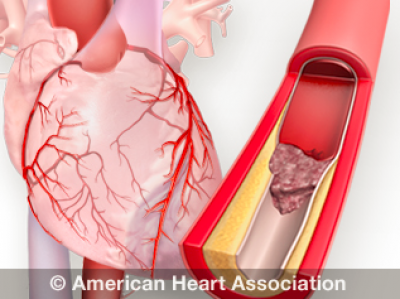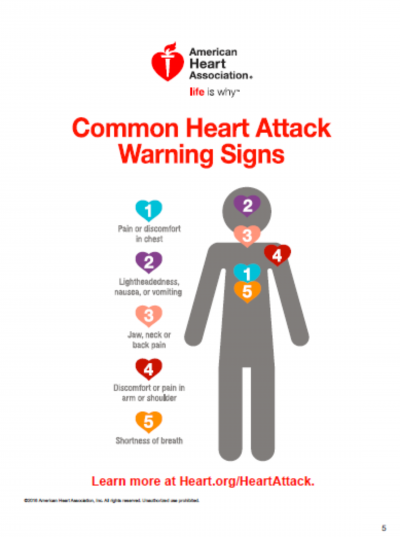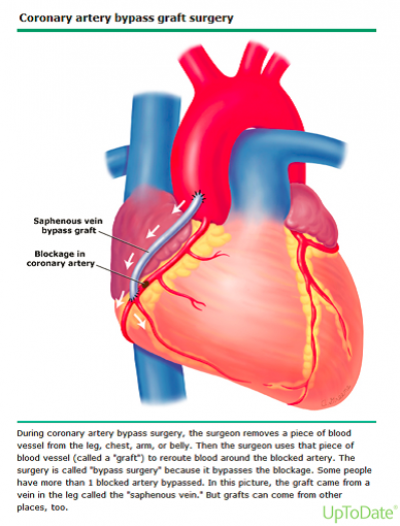Let’s ask ourselves a few questions
• Does anyone in the family have a history of heart disease, high blood pressure, stroke, or diabetes?
• Has anyone in your family died suddenly?
• Are you overweight?
• Do you have diabetes or “borderline elevated glucose”
• Do you smoke or live/work around a smoker?
• Is your cholesterol elevated?
• Do you live in a stressful environment?
• Are you older than 40?
• Do you exercise regularly? (Walking counts as exercise)
• Do you eat meat?
What is a heart attack?
A heart attack, also called myocardial infarction, or MI, is what happens when one of the arteries that supply blood to the heart gets blocked. When this happens, the part of the heart that normally gets blood from that artery is damaged. The longer the time the artery is blocked, the bigger the heart attack. The arteries that supply blood to the heart are called the "coronary arteries."


Heart attacks are usually the result of a condition called "coronary heart disease" or "coronary artery disease." In this disease, fatty deposits called plaques form on the walls of the coronary arteries. These plaques sometimes break open and cause blood clots to form. Then the blood clot can block off the artery and keep blood from reaching parts of the heart muscle. That is what causes most heart attacks.
What are the symptoms of a heart attack?
People having a heart attack often notice:
• Pain, pressure, or discomfort in the chest
• Pain, tingling, or discomfort in other parts of the upper body, including the arms, back, neck, jaw, or stomach
• Shortness of breath
• Nausea, vomiting, burping, or heartburn
• Sweating or cold, clammy skin
• A racing or uneven heartbeat
• Feeling dizzy or lightheaded

Symptoms vary between men and women
As with men, women’s most common heart attack symptom is chest pain or discomfort. But women are somewhat more likely than men to experience some of the other common symptoms, particularly shortness of breath, nausea/vomiting, and back or jaw pain.
Is there a test for heart attacks?
Yes. If your doctor thinks you are having a heart attack, he or she might order one or more of these tests:
• An electrocardiogram (ECG) – This test measures the electrical activity in your heart.
• Blood tests – During a heart attack, the heart releases certain chemicals. If these chemicals are in your blood, it might mean you are having a heart attack.
• Echocardiogram – This test uses sound waves to create an image of your heart as it beats. In a heart attack, not all parts or the heart pump normally.
• Cardiac catheterization (also called "cardiac cath") – During this test, the doctor puts a thin tube into a blood vessel in your leg or arm. Then he or she moves the tube up to your heart. Next, the doctor puts a dye that shows up on X-ray into the tube. This part of the test is called "coronary angiography." It can show whether any of the arteries in your heart are clogged.
How is a heart attack treated?
If you go to the hospital while you are having a heart attack, the doctors and nurses will do a few things:
• They might give you oxygen through a mask or a tube in your nose.
• They will give you pain medicines to ease the chest pain and discomfort of a heart attack. They might also give you something to help you relax.
• They will give you medicines to help keep more blood clots from forming.
• They might give you a medicine called a beta blocker to reduce your heart's need for oxygen. This medicine can help reduce the damage caused by a heart attack.
• They will try to get blood flowing again through the clogged artery. Doctors can do this in 1 of 2 ways:
-
They can give you medicines through a thin tube that goes into a vein, called an "IV," to break up clots. These have been called "clot busters."
- They can do a procedure called "stenting" combination with cardiac catheterization. This involves putting a tiny metal tube called a "stent" into the blocked artery to hold it open.
If you cannot get a stent, or if the stent does not work, your doctor might suggest open heart surgery. This is also called "coronary artery bypass grafting" or "bypass surgery" During this surgery, doctors create a new path – a detour – for blood to get around the clogged portion of the artery. They do this using a combination of your own arteries and veins.


You will likely stay in the hospital for 3 to 5 days, unless your heart attack led to other problems that need treatment.
How Can You Reduce Your Risk Of A Heart Attack?
• 70% of the heart attacks we see at First Cardiology are preventable.
• Eat healthy: reduce fried foods. eg; boiled yam instead of fried yam chips, grilled plantain instead of fried dodo. Grilled or cooked fish instead of meat. Boiled or poached eggs not fried. More fruits and vegetables. Eat foods high in fiber and less refined carbohydrates
• Get some exercise; walking 30-60 minutes a day is great, aim for 5,000-10,000 steps a day. Walk up the stairs instead of using the elevator
• Stop smoking( many of us are closet smokers)
• Go for your annual check up and please follow your doctors advice.
• If your blood pressure is high please take your medications, if there are concerns about possible side effects speak to your doctor. It is critical your blood pressure is below 140/90.
• If your blood glucose is elevated it should be controlled with diet and medications as prescribed by your doctor.
• Elevated Cholesterol should be controlled with diet and medications as recommended by your doctor.
What do you do if you think you might be having a heart attack? It might be a family member, friend or colleague at work.
It is critical you act quickly, the sooner treatment is started the more likely it is you survive without permanent damage.
• Take aspirin 2-4 tablets of baby aspirin
• Get to the nearest hospital that has the facilities to treat a heart attack (after reading this, go and find out which hospital near you (home and work) has the appropriate facilities and professional staff).
ADEYEMI JOHNSON, MD FACC
FIRST CARDIOLOGY CONSULTANTS
20A Thompson Avenue, Ikoyi, Lagos
08035250205
